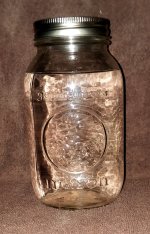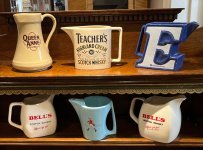About thirty years ago the head taster of the McCormick distillery at Weston, Missouri took us on a splendid tour.
There was an old copper still they had out to show the tourist how whiskey used to be made at the distillery.
But at that time, he said McCormick contracted all their distilling from industrial alcohol plants in Illinois.
He said there was no magic in taking a certain mash bill and distilling it.
The flavor and quality of bourbon comes entirely from aging in new, charred white oak barrels and the tasting of it to know when it’s ready to bottle.
Generally more aging is better, but each barrel will have subtle differences depending on the char, the variation of the barrels, and even where on the rick the barrel is placed to age, the attic aged generally is preferred.
The very best bourbon was tasted and bottled at it’s prime, whatever that prime was.
The barrels originally were charred to mask the flavors of whatever the barrel had been used for, but for over a century only brand new charred white oak barrels were used, by law.
There were four char levels:
Xxxx
When wood is heated, the hemicellulose and cellulose present in it separate into sugars. These sugars carry rich flavors such as toffee, caramel, maple, brown sugar, and nut. The oak's lignin fibers also separate, providing distinct flavor profiles. The oak may contain particles such as vanillin, which provides a vanilla taste, or eugenol, which tastes of cloves. The more a barrel is charred, the spicier the lignin's flavor contribution becomes.
Oak lactones contribute a mild coconut flavor. This taste is more pronounced in lightly charred barrels. A deeper char will damage the lactones, nullifying their effect.
The wood's tannins are released in the charring process as well. After the barrel is charred, it's left to dry out. This removes the harsher tannins that you don't want in your drink. The remaining tannins are more desirable. These will mellow the interaction between the spirit and tannin throughout the maturation process.
The oak variety and place of origin contribute to the wood's unique makeup. Every type of oak is different, with a distinctive profile of lignin, lipid, cellulose, and hemicellulose.
What Are the Char Levels?
There are four different char levels that most distilleries ascribe to.
- Level 1 char: This 15-second char is the lightest option, making the bourbon slightly sweeter with some slight campfire notes.
- Level 2 char: The 30-second Level 2 char delivers notes of coffee and vanilla. It also adds a bit of spice to the finished bourbon.
- Level 3 char: After this 35-second char, you'll notice a hint of caramelization with notes of vanilla and a spicy flavor.
- Level 4 char: Lasting 55 seconds, this intense char offers the deepest flavor highlighted with a few sweeter notes.
Xxxxx








.gif)

